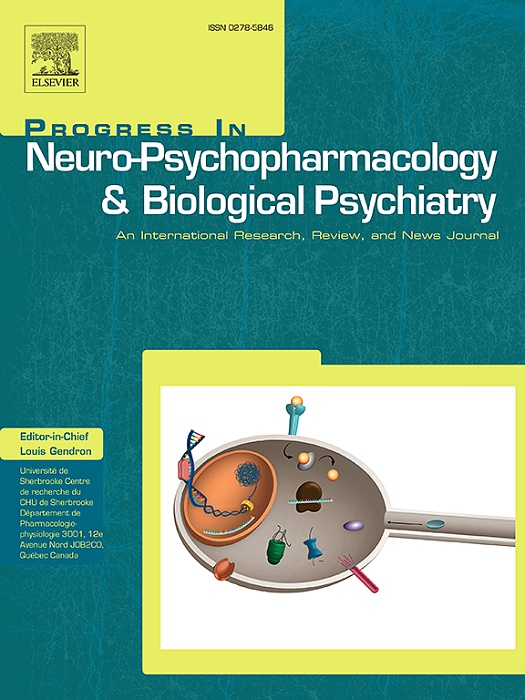对炎症性肠病与阿尔茨海默病之间联系的孟德尔随机化和遗传多效性分析。
IF 5.3
2区 医学
Q1 CLINICAL NEUROLOGY
Progress in Neuro-Psychopharmacology & Biological Psychiatry
Pub Date : 2024-11-22
DOI:10.1016/j.pnpbp.2024.111203
引用次数: 0
摘要
背景:肠道-微生物组-脑轴(GMBA)意味着炎症性肠病(IBD)与阿尔茨海默病(AD)之间的联系。我们旨在从遗传多效性的角度全面探讨 IBD(及其亚型)与 AD、早发 AD(EOAD)和晚发 AD(LOAD)之间的关系:根据汇总统计数据(N = 472,868 例 AD、185,204 例 EOAD、191,061 例 LOAD、59,957 例 IBD、45,975 例 CD 和 40,266 例 UC),我们首先进行了孟德尔随机化(Mendelian Randomization),利用垂直多效性研究了 IBD 和 AD 之间的因果关系。然后,我们估算了全局和局部遗传相关性,接着进行了跨性状关联分析,以确定具有横向多效性的 SNP 和基因。特别是,我们利用多性状共定位分析来评估微生物在这两类疾病的共同遗传病因中的作用。最后,我们对多效基因进行了功能富集分析:结果:我们发现 IBD(及其亚型)与 EOAD(ORIBD = 1.06 [1.01-1.11],ORCD = 1.05 [1.01-1.10],ORUC = 1.08 [1.01-1.15])以及 UC 与 LOAD(OR = 1.04 [1.01-1.08])之间存在提示性因果关系,并发现 44 个局部区域显示 IBD(及其亚型)与 AD(以及 EODA 和 LOAD)之间存在提示性显著遗传相关性。我们还发现了大量的遗传重叠,其特点是有 182 个与 CE 相关、3 个与 EOAD 相关和 51 个与 LOAD 相关的多向性 SNP 以及 291 个多向性基因。多向性基因更有可能富集在与 GMBA 相关的组织中,如大脑、肠道和食道。此外,我们还发现了三种与这些疾病对相关的微生物,包括卡氏杆菌、梭菌和普雷沃特菌:结论:IBD及其亚型与AD、EOAD和LOAD之间的提示性因果关系和共同遗传基础可能是它们共同发生的常见原因,而肠道微生物可能是共同遗传病因的部分原因。我们有必要开展进一步的研究,以阐明这两类疾病可能的生物学机制。本文章由计算机程序翻译,如有差异,请以英文原文为准。
Mendelian randomization and genetic pleiotropy analysis for the connection between inflammatory bowel disease and Alzheimer's disease
Background
The gut-microbiome-brain axis (GMBA) implies the connection between inflammatory bowel disease (IBD) and Alzheimer's disease (AD). We aimed to comprehensively explore the relation between IBD (and its subtypes) and AD, early-onset AD (EOAD) and late-onset AD (LOAD) from a genetic pleiotropy perspective.
Methods
Relying on summary statistics (N = 472,868 for AD, 185,204 for EOAD, 191,061 for LOAD, 59,957 for IBD, 45,975 for CD, and 40,266 for UC), we first performed Mendelian Randomization to examine the causal association between IBD and AD by leveraging vertical pleiotropy. Then, we estimated global and local genetic correlations, followed by cross-trait association analysis to identify SNPs and genes with horizontal pleiotropy. Particularly, we utilized multi-trait colocalization analysis to assess the role of microbes in the common genetic etiology underlying the two types of diseases. Finally, we conducted functional enrichment analysis for pleiotropic genes.
Results
We discovered suggestively causal relations between IBD (and its subtypes) and EOAD (ORIBD = 1.06 [1.01–1.11], ORCD = 1.05 [1.01–1.10], ORUC = 1.08 [1.01–1.15]) as well as between UC and LOAD (OR = 1.04 [1.01–1.08]), and discovered 44 local regions showing suggestively significant genetic correlations between IBD (and its subtypes) and AD (and EODA and LOAD). We further detected substantial genetic overlap, as characterized by 182 AD-associated, 3 EOAD-associated and 51 LOAD-associated pleiotropic SNPs as well as 291 pleiotropic genes. Pleiotropic genes more likely enriched in the GMBA-relevant tissues such as brain, intestine and esophagus. Moreover, we identified three microorganisms related to these disease pairs, including the Catenibacterium, Clostridia, and Prevotella species.
Conclusion
The suggestively causal associations and shared genetic basis between IBD and its subtypes with AD, EOAD and LOAD may commonly drive their co-occurrence, and gut microbes might partly explain the shared genetic etiology. Further studies are warranted to elaborate the possibly biological mechanisms underlying the two types of diseases.
求助全文
通过发布文献求助,成功后即可免费获取论文全文。
去求助
来源期刊
CiteScore
12.00
自引率
1.80%
发文量
153
审稿时长
56 days
期刊介绍:
Progress in Neuro-Psychopharmacology & Biological Psychiatry is an international and multidisciplinary journal which aims to ensure the rapid publication of authoritative reviews and research papers dealing with experimental and clinical aspects of neuro-psychopharmacology and biological psychiatry. Issues of the journal are regularly devoted wholly in or in part to a topical subject.
Progress in Neuro-Psychopharmacology & Biological Psychiatry does not publish work on the actions of biological extracts unless the pharmacological active molecular substrate and/or specific receptor binding properties of the extract compounds are elucidated.

 求助内容:
求助内容: 应助结果提醒方式:
应助结果提醒方式:


